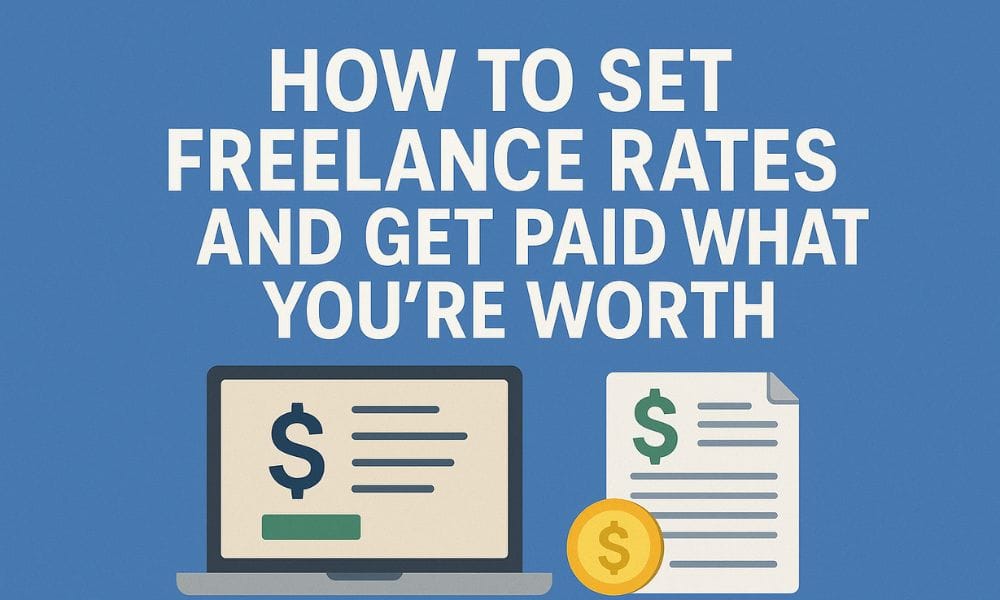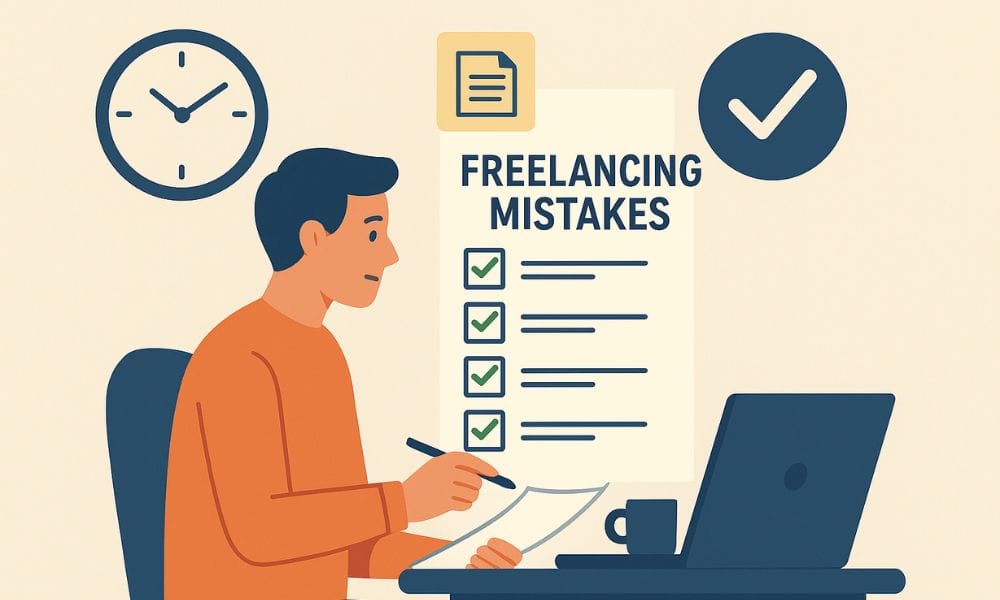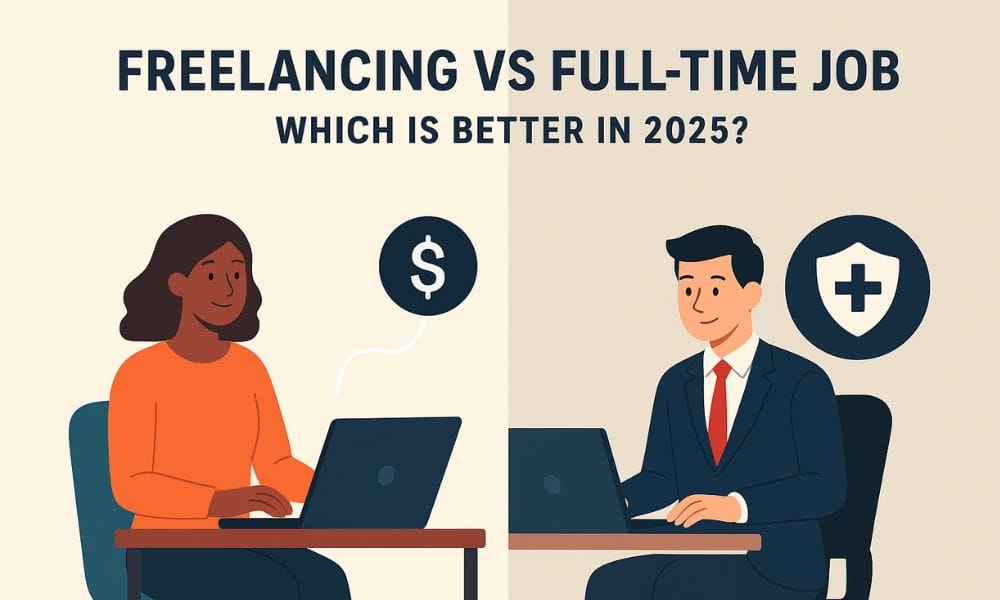How to Set Freelance Rates and Get Paid What You’re Worth
If you’re new to freelancing, one of the biggest questions you’ll face is how to decide what to charge. Figuring out how to set freelance rates can feel confusing at first. You don’t want to undersell yourself, but you also don’t want to scare off clients with prices that seem too high.
This guide will help you find a rate that’s fair for you and attractive to clients. You’ll learn how to calculate your pricing, adjust it as your skills grow, and communicate your value confidently — so you’re paid what you truly deserve.
If you’re still building your foundation, check out our Complete Guide to Freelancing. Once you’ve got your footing, this article will walk you through how to price your work like a pro.
Why Setting the Right Rate Matters
Your rate affects everything about your freelance business. It shapes the kind of clients you attract, the projects you take on, and how stable your income becomes.
When freelancers charge less than they’re worth, they often end up taking on too many projects and working long hours for small pay. But if you set your rates unrealistically high without showing the value you offer, clients may hesitate to hire you.
The goal is to find that middle ground — where your rate reflects your experience, covers your expenses, and still makes sense for your target market.
Understand Your Value Before You Set a Price
Before setting your rate, get clear on what makes your work valuable. Think beyond hours and effort. Ask yourself:
- What unique skills do I bring to the table?
- How long have I been practicing this craft?
- What measurable results do I deliver for clients?
If your work helps a business grow, save time, or increase revenue, that’s value — and your rate should match it.
If you’re still working on improving your skill set, take a look at our post on Top Freelancing Skills to Learn in 2025. The more in-demand skills you develop, the easier it becomes to justify higher rates and attract quality clients.
How to Calculate Your Freelance Rate
Instead of guessing what to charge, use a simple calculation to set a realistic baseline.
- Start with your annual income goal.
Suppose you want to earn $60,000 a year. - Add your yearly business expenses.
Think of taxes, internet, subscriptions, and tools. If that’s around $5,000, your total target income becomes $65,000. - Estimate your billable hours.
Not all work hours are billable. You’ll spend time on admin, outreach, and learning. Around 1,000 billable hours per year (20 per week) is a fair estimate. - Do the math.
$65,000 ÷ 1,000 = $65/hour.
That’s your starting point. You can raise or lower it based on your experience, project type, or niche demand.
If you’re just beginning and want a simple roadmap to attract clients, check out How to Start Freelancing With No Experience.
What Influences Freelance Rates
Your rate isn’t just about math — it’s about context. A few key things influence what you can charge:
- Experience: The more you’ve worked in your field, the higher your rates can be.
- Industry: Some fields, like web development and marketing, pay more than others.
- Project type: A quick social media post isn’t the same as a full campaign or website build.
- Client type: Small startups usually have smaller budgets than established brands.
- Location and taxes: Always consider where you live and the cost of doing business.
The best freelancers review their rates every six months or after completing major projects. Growth should show up in both your portfolio and your pricing.
Common Pricing Models for Freelancers
There are several ways to charge for your work, and each has its pros and cons.
| Model | When It Works Best | Pros | Cons |
|---|---|---|---|
| Hourly | Short or flexible tasks | Easy for clients to understand | Limits how much you can earn per project |
| Project-based | Clearly defined deliverables | Predictable income and scope | Risk of underestimating time |
| Value-based | High-impact work tied to results | Rewards expertise, not time | Takes practice to price correctly |
For example, if you’re a copywriter whose work helps clients increase sales, a value-based model might make more sense than charging per hour. It’s about the outcome, not the time.
Research the Market Before You Set a Rate
Before sending a quote, look at what others charge in your niche. You can browse Upwork, Fiverr, or Contra — three of the Best Freelance Platforms to Find Work in 2025. These sites give you a sense of what people with similar skills and experience are earning.
You can also check LinkedIn Salary to compare with full-time professionals in your field. It’s not a perfect match, but it can help you gauge the market value of your skills.
Use that information to position yourself wisely — not the cheapest, but not out of reach either.
When and How to Raise Your Rates
Once you’ve gained experience and have consistent work, it’s time to raise your prices. You might be ready if:
- You’re fully booked most of the time.
- Clients accept your quotes without hesitation.
- You’ve added new skills, certifications, or achievements.
- You consistently deliver measurable results.
Here’s a simple way to let clients know about an increase:
“I’ve updated my pricing to reflect the quality and results I provide. Starting [date], my rate for new projects will be [$X]. I really appreciate your continued trust and look forward to working together.”
Clients who value your work will understand.
What to Do When Clients Say You’re Too Expensive
You’ll eventually meet clients who think your rates are too high. Instead of dropping your price, try this:
- Focus on value. Explain how your work helps them save time or make more money.
- Offer smaller packages. Create a simpler version of your service that fits their budget.
- Know when to walk away. Some clients just aren’t the right match for your work or pricing, and that’s completely fine.
Setting firm boundaries attracts better clients who appreciate quality.
Make Sure You Get Paid on Time
Once you’ve set your rate, protect your income with good habits. Here’s how:
- Always use contracts that clearly outline payment terms.
- Ask for a deposit before you start working (30–50% is standard).
- Send invoices through trusted tools like FreshBooks, Payoneer, or Wise.
- Follow up professionally on overdue payments and keep communication in writing.
If you’re using freelance platforms, take advantage of their payment protection features to stay secure.
Checklist: How to Set Freelance Rates Confidently
✅ Identify your skills and strengths
✅ Define your annual income goal
✅ Add expenses and taxes
✅ Calculate your base rate
✅ Research what others charge
✅ Choose the right pricing model
✅ Review your rates regularly
✅ Use contracts and deposits
FAQs About How to Set Freelance Rates
1. How do I know if I’m charging too little?
If you’re booked solid but not meeting your income goals, you’re likely undercharging.
2. Should beginners start with low rates?
You can start modestly to build experience but raise your rates once you’ve built trust and results.
3. What’s a good hourly rate in 2025?
Depending on your skill and field, most freelancers charge between $30–$120 an hour.
4. How often should I adjust my rates?
Review every 6–12 months or after completing major projects or training.
5. How do I tell clients about rate changes?
Be clear, professional, and confident. Give notice before the new rate takes effect.
6. What if a client doesn’t pay?
Always use contracts and secure payment methods. Tools like Payoneer or FreshBooks can help track payments safely.
7. Should I post my rates online?
That’s up to you. Some freelancers list “starting rates” to filter clients; others quote custom prices.
8. How do I handle clients with small budgets?
Offer scaled-down options rather than cutting your core rate.
9. What’s the difference between hourly and value-based pricing?
Hourly is about time spent; value-based is about results delivered.
10. How can I make steady income as a freelancer?
Build long-term relationships and retainers. Learn more in our Guide to Freelancing.
Final Thoughts
Learning how to set freelance rates takes practice, but once you do, everything else gets easier. You’ll attract better clients, feel more confident, and finally get paid for the real value of your work.
Don’t race to the bottom. Compete on quality, reliability, and results — not price. Over time, the right clients will recognize your worth and happily pay for it.
To keep improving your freelance business, check out our Complete Guide to Freelancing for practical steps to grow, manage, and scale your career.



